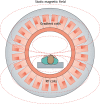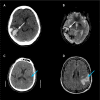Current approaches and advances in the imaging of stroke
- PMID: 34874055
- PMCID: PMC8669490
- DOI: 10.1242/dmm.048785
Current approaches and advances in the imaging of stroke
Abstract
A stroke occurs when the blood flow to the brain is suddenly interrupted, depriving brain cells of oxygen and glucose and leading to further cell death. Neuroimaging techniques, such as computed tomography and magnetic resonance imaging, have greatly improved our ability to visualise brain structures and are routinely used to diagnose the affected vascular region of a stroke patient's brain and to inform decisions about clinical care. Currently, these multimodal imaging techniques are the backbone of the clinical management of stroke patients and have immensely improved our ability to visualise brain structures. Here, we review recent developments in the field of neuroimaging and discuss how different imaging techniques are used in the diagnosis, prognosis and treatment of stroke.
Keywords: Computed tomography; Haemorrhagic stroke; Ischaemic stroke; Magnetic resonance imaging; Neuroimaging; Stroke.
© 2021. Published by The Company of Biologists Ltd.
Conflict of interest statement
Competing interests The authors declare no competing or financial interests.
Figures





Similar articles
-
Neuroimaging of Acute Stroke.Neurol Clin. 2020 Feb;38(1):185-199. doi: 10.1016/j.ncl.2019.09.004. Epub 2019 Nov 7. Neurol Clin. 2020. PMID: 31761058 Review.
-
Ischemic stroke.Radiol Clin North Am. 2011 Jan;49(1):1-26. doi: 10.1016/j.rcl.2010.07.010. Radiol Clin North Am. 2011. PMID: 21111127 Review.
-
Perfusion imaging in ischaemic stroke.J Pak Med Assoc. 2008 Jul;58(7):391-4. J Pak Med Assoc. 2008. PMID: 18988413 Review.
-
Computed tomography versus short sequence magnetic resonance imaging in acute ischaemic stroke.J Neurol Sci. 2023 May 15;448:120638. doi: 10.1016/j.jns.2023.120638. Epub 2023 Mar 30. J Neurol Sci. 2023. PMID: 37018964 No abstract available.
-
Neuroimaging of cerebral ischemia and infarction.Neurotherapeutics. 2011 Jan;8(1):19-27. doi: 10.1007/s13311-010-0004-2. Neurotherapeutics. 2011. PMID: 21274682 Free PMC article. Review.
Cited by
-
Long Non-Coding RNAs as Diagnostic Biomarkers for Ischemic Stroke: A Systematic Review and Meta-Analysis.Genes (Basel). 2024 Dec 18;15(12):1620. doi: 10.3390/genes15121620. Genes (Basel). 2024. PMID: 39766887 Free PMC article.
-
Evaluation of stroke sequelae and rehabilitation effect on brain tumor by neuroimaging technique: A comparative study.PLoS One. 2025 Feb 24;20(2):e0317193. doi: 10.1371/journal.pone.0317193. eCollection 2025. PLoS One. 2025. PMID: 39992898 Free PMC article.
-
Deep vein thrombosis in Ethiopia: a systematic review and meta-analysis, 2025.Thromb J. 2025 Jun 20;23(1):68. doi: 10.1186/s12959-025-00760-6. Thromb J. 2025. PMID: 40542335 Free PMC article. Review.
-
Neurobiological Insights Into Cerebral Palsy: A Review of the Mechanisms and Therapeutic Strategies.Brain Behav. 2024 Oct;14(10):e70065. doi: 10.1002/brb3.70065. Brain Behav. 2024. PMID: 39378294 Free PMC article. Review.
-
Detecting Stroke at the Emergency Department by a Point of Care Device: A Multicenter Feasibility Study.Med Devices (Auckl). 2024 Mar 5;17:107-112. doi: 10.2147/MDER.S445075. eCollection 2024. Med Devices (Auckl). 2024. PMID: 38476129 Free PMC article.
References
-
- Abedi, V., Goyal, N., Tsivgoulis, G., Hosseinichimeh, N., Hontecillas, R., Bassaganya-Riera, J., Elijovich, L., Metter, J. E., Alexandrov, A. W. and Liebeskind, D. S. (2017). Novel screening tool for stroke using artificial neural network. Stroke 48, 1678-1681. 10.1161/STROKEAHA.117.017033 - DOI - PubMed
-
- Albers, G. W., Thijs, V. N., Wechsler, L., Kemp, S., Schlaug, G., Skalabrin, E., Bammer, R., Kakuda, W., Lansberg, M. G. and Shuaib, A. (2006). Magnetic resonance imaging profiles predict clinical response to early reperfusion: the diffusion and perfusion imaging evaluation for understanding stroke evolution (DEFUSE) study. Ann. Neurol. 60, 508-517. 10.1002/ana.20976 - DOI - PubMed
-
- Arab, A., Chinda, B., Medvedev, G., Siu, W., Guo, H., Gu, T., Moreno, S., Hamarneh, G., Ester, M. and Song, X. (2020). A fast and fully-automated deep-learning approach for accurate hemorrhage segmentation and volume quantification in non-contrast whole-head CT. Sci. Rep. 10, 1-12. 10.1038/s41598-020-76459-7 - DOI - PMC - PubMed

